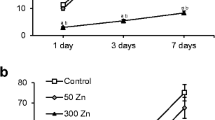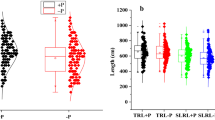Abstract
Ten Triticum aestivum and two Triticum turgidum conv. durum genotypes were grown in chelate-buffered nutrient solution at Zn supplies ranging from deficient to sufficient (free Zn activities from 2 to 200 pM, pZn from 11.7 to 9.7). The critical level of Zn ion activity in solution for healthy growth of wheat plants was around 40 pM. Genotypes differed in the growth response: those classified as Zn-efficient suffered less reduction of shoot growth and did not change the rate of root growth at a Zn supply quite deficient for Zn-inefficient genotypes. Root growth of Zn-inefficient genotypes increased at deficient Zn supply. The shoot/root ratio was the most sensitive parameter of Zn efficiency; Zn-efficient genotypes showed less reduction in the ratio when grown at deficient compared to sufficient Zn supply. Classification of wheat genotypes into Zn-efficient and Zn-inefficient groups after screening in chelate-buffered nutrient solution corresponded well with classification obtained in field experiments on Zn-deficient soil.
Similar content being viewed by others
References
Bell P F, Chaney R L and Angle J S 1991 Free metal activity and total metal concentrations as indices of micronutrient availability to barley [Hordeum vulgare (L.) ‘Klages’]. Plant and Soil 130, 51–62.
Bell R W, Kirk G J, Plaskett D and Loneragan J F 1990 Diagnosis of zinc deficiency in peanut (Arachis hypogea) by plant analysis. Commun. Soil Sci. Plant Anal. 21, 273–285.
Cakmak I and Marschner H 1988 Increase in membrane permeability and exudation in roots of zinc deficient plants. J. Plant Physiol. 132, 356–361.
Cakmak I, Marschner H and Bangerth F 1989 Effect of zinc nutritional status on growth, protein metabolism and levels of indole-3-acetic acid and other phytohormones in bean (Phaseolus vulgaris L.). J. Exp. Bot. 40, 405–412.
Chaney R L, Bell P F and Coulombe B A 1989 Screening strategies for improved nutrient uptake and utilization by plants. HortScience 24, 565–572.
Dang Y P, Edwards D G, Dalal R C and Tiller K G 1993 Identification of an index tissue to predict zinc status of wheat. Plant and Soil 154, 161–167.
Freeden A L, Rao I M and Terry N 1989 Influence of phosphorus nutrition on growth and carbon partitioning in Glycine max. Plant Physiol. 89, 225–230.
GENSTAT 5 Committee 1989 GENSTAT 5. Reference Manual. Clarendon Press, Oxford, UK.
Graham R D, Ascher J S and Hynes S C 1992 Selecting zinc-efficient cereal genotypes for soils of low zinc status. Plant and Soil 146, 241–250.
Graham R D and Rengel Z 1993 Genotypic variation in zinc uptake and utilization by plants. In Zinc in Soils and Plants. Ed. A DRobson. pp 107–118. Kluwer Academic Publishers, dordrecht, the Netherlands.
Grundon N J 1987 Hungry Crops: A Guide to Nutrient Deficiencies in Field Crops. Queensland Department of Primary Industries, Brisbane 242p.
Jackson M B 1993 Are plant hormones involved in root to shoot communication? Adv. Bot. Res. 19, 103–187.
Laurie S H, Tancock N P, McGrath S P and Sanders J R 1991 Influence of complexation on the uptake by plants of iron, manganese, copper and zinc. I. Effect of EDTA in a multi-metal and computer simulation study. J. Exp. Bot. 42, 509–513.
Loneragan J F, Grunes D L, Welch R M, Aduayi E A, Tengah A, Lazar V A and Cary E E 1982 Phosphorus accumulation and toxicity in leaves in relation to zinc supply. Soil Sci. Soc. Am. J. 46, 345–352.
MacNair M R 1993 The genetics of metal tolerance in vascular plants. New Phytol. 124, 541–559.
Nable R O and Webb M J 1993 Further evidence that zinc is required throughout the root zone for optimal plant growth and development. Plant and Soil 150, 247–253.
Norvell W A, Dabkovska-Naskret H and Cary E E 1987 Effect of phosphorus and zinc fertilization on the solubility of Zn2+ in two alkaline soils. Soil Sci. Soc. Am. J. 51, 584–588.
Norvell W A and Welch R M 1993 Growth and nutrient uptake by barley (Hordeum vulgare L. cv Herta): Studies using an N-(2-hydroxyethyl)ethylenedinitrilotriacetic acid-buffered nutrient solution technique. I. Zinc ion requirements. Plant Physiol. 101, 619–625.
Paivoke A 1983 The long term effect of zinc on growth and development, chlorophyll content and nitrogen fixation in the garden pea. Ann. Bot. Fenn. 20, 205–213.
Parker D R 1993 Novel nutrient solutions for zinc nutrition research: buffering free zinc2+ with synthetic chelators and P with hydroxyapatite. In Plant Nutrition-from Genetic Engineering to Field Practice. Ed. N JBarrow. pp 677–680. Kluwer Academic Publishers, Dordrecht, the Netherlands.
Parker D R, Aguilera J J and Thomason D N 1992 Zinc-phosphorus interactions in two cultivars of tomato (Lycopersicon esculentum L.) grown in chelator-buffered nutrient solutions. Plant and Soil 143, 163–177.
Parker D R, Norvell W A and Chaney R L 1995 GEOCHEM-PC-A chemical speciation program for IBM and compatible personal computers. In Chemical Equilibrium and Reaction Models. Eds. R HLoeppert, A PSchwab and SGoldberg. ASA, SSSA, Madison, WI, USA. pp 253–269.
Rengel Z 1990 Competitive Al3+ inhibition of net Mg2+ uptake by intact Lolium multiflorum roots. II. Plant age effects. Plant Physiol. 93, 1261–1267.
Rengel Z and Graham R D 1995a Importance of seed Zn content for wheat growth on Zn-deficient soil. I. Vegetative growth. Plant and Soil 173, 259–266.
Rengel Z and Graham R D 1995b Wheat genotypes differ in Zn efficiency when grown in the chelate-buffered nutrient solution. II. Nutrient uptake. Plant and Soil 176, 317–324.
Rengel Z and Jurkic V 1992 Genotypic differences in wheat Al tolerance. Euphytica 62, 111–117.
Reuter D J and Robinson J B 1986 Plant Analysis. An Interpretation Manual. Inkata Press, Melbourne, Australia.
Sillanpää M and Vlek P L G 1985 Micronutrients and the agroecology of tropical and Mediterranean regions. Fert. Res. 7, 151–167.
Webb M J and Loneragan J F 1988 Effect of zinc deficiency on growth, phosphorus concentration, and phosphorus toxicity of wheat plants. Soil Sci. Soc. Am. J. 52, 1676–1680.
Webb M J and Loneragan J F 1990 Zinc translocation to wheat roots and its implications for a phosphorus/zinc interaction in wheat plants. J. Plant Nutr. 13, 1499–1512.
Welch R M and Norvell W A 1993 Growth and nutrient uptake by barley (Hordeum vulgare L. cv Herta): Studies using an N-(2-hydroxyethyl)ethylenedinitrilotriacetic acid-buffered nutreint solution technique. I. Role of zinc in the uptake and root leakage of mineral nutrients. Plant Physiol. 101, 627–631.
Yang X, Römheld V and Marschner H 1994 Application of chelatorbuffered nutrient solution technique in studies on zinc nutrition in rice plant (Oryza sativa L.). Plant and Soil 163, 85–94.
Author information
Authors and Affiliations
Rights and permissions
About this article
Cite this article
Rengel, Z., Graham, R.D. Wheat genotypes differ in Zn efficiency when grown in chelate-buffered nutrient solution. Plant Soil 176, 307–316 (1995). https://doi.org/10.1007/BF00011795
Received:
Accepted:
Issue Date:
DOI: https://doi.org/10.1007/BF00011795




